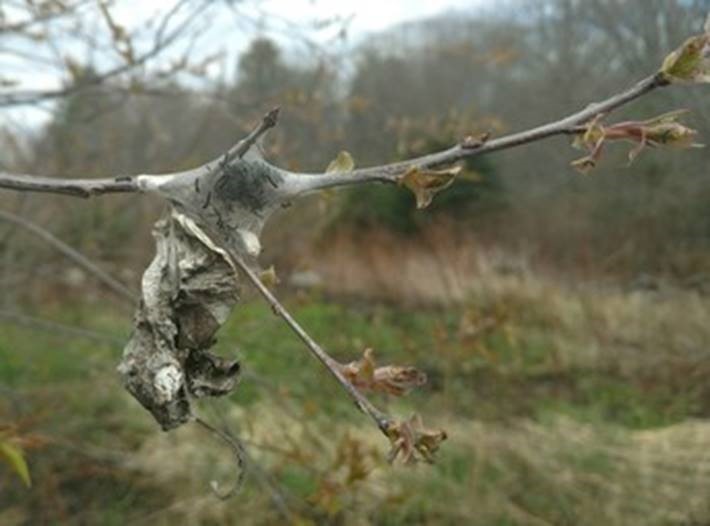Browntail Moth Update for May 13, 2022
As noted last week, browntail caterpillars have begun producing silk and have expanded the winter webs. There is a native look-alike, called eastern tent caterpillar, that can be confused for browntail moth webs at this stage in development. Two key differences between the webs these species make are size and position on the tree. The silken nests of native eastern tent caterpillars start small but can grow quite large, reaching around the size of a football and are attached to the tree where the branches meet the trunk or come together. Additionally eastern tent caterpillars lack the two characteristic orange spots on the tail end of the caterpillar.
Browntail winter webs are the size of your palm or smaller, are constructed in late summer and early fall on the tips of the branches and are comprised of silk that also incorporates the leaves on the branch tips. As the caterpillars become active in the spring, they travel in and out of the web, and the web can become surrounded in gauzy silk similar in texture to that made by eastern tent caterpillar. Browntail moth caterpillars are dark brown and have two orange spots towards the rear of their bodies. As the caterpillars molt, they develop white stripes due to white tufts of hair on each segment.
The photo below shows an eastern tent caterpillar nest (upper) next to a browntail moth winter web (lower) (note, the eastern tent caterpillar nest is less dense and will continue to enlarge as it develops through the spring and summer).
 Image: Browntail moth winter web next to eastern tent caterpillar web. MFS.
Earlier this month, the Governor signed LD1929, An Act to Provide Assistance to Areas Severely Infested with Browntail Moth, into law. The law, which will be in effect later this summer, directs the Department to create a program, in part through rule-making, to distribute $150,000 to government entities, such as cities or towns, or nonprofits to mitigate browntail moth. We will work to develop that program in the coming months, with the goal of having procedures in place by the end of 2022 so that funds can be distributed in early 2023. It is our hope that these funds will help more organizations engage in efforts to reduce the impacts from browntail moth.
Contact 211 Maine for answers to frequently asked questions on browntail moths:
- Dial 211 (or 207-874-2211)
- Text your zip code to 898-211
Or visit our website.

|